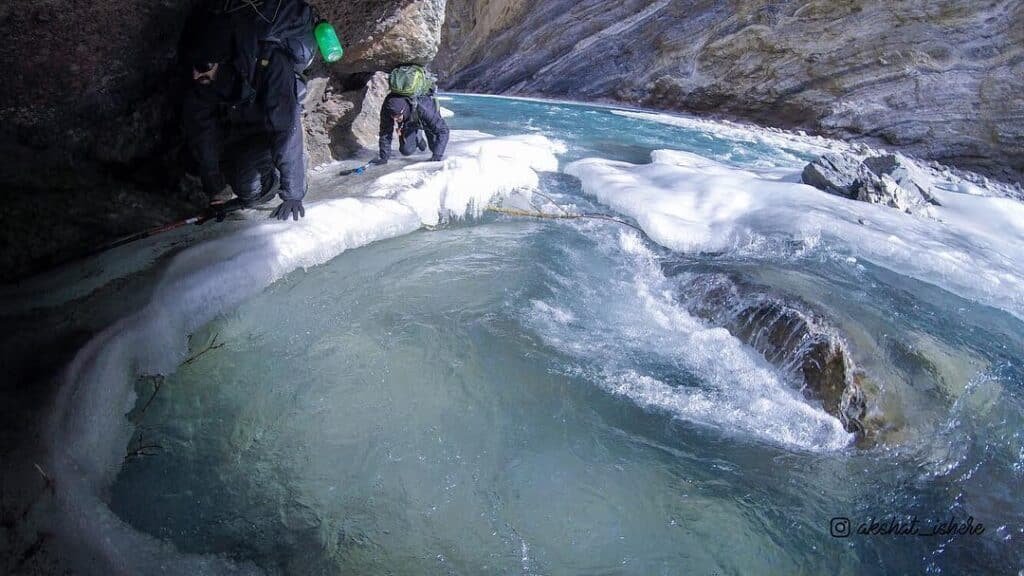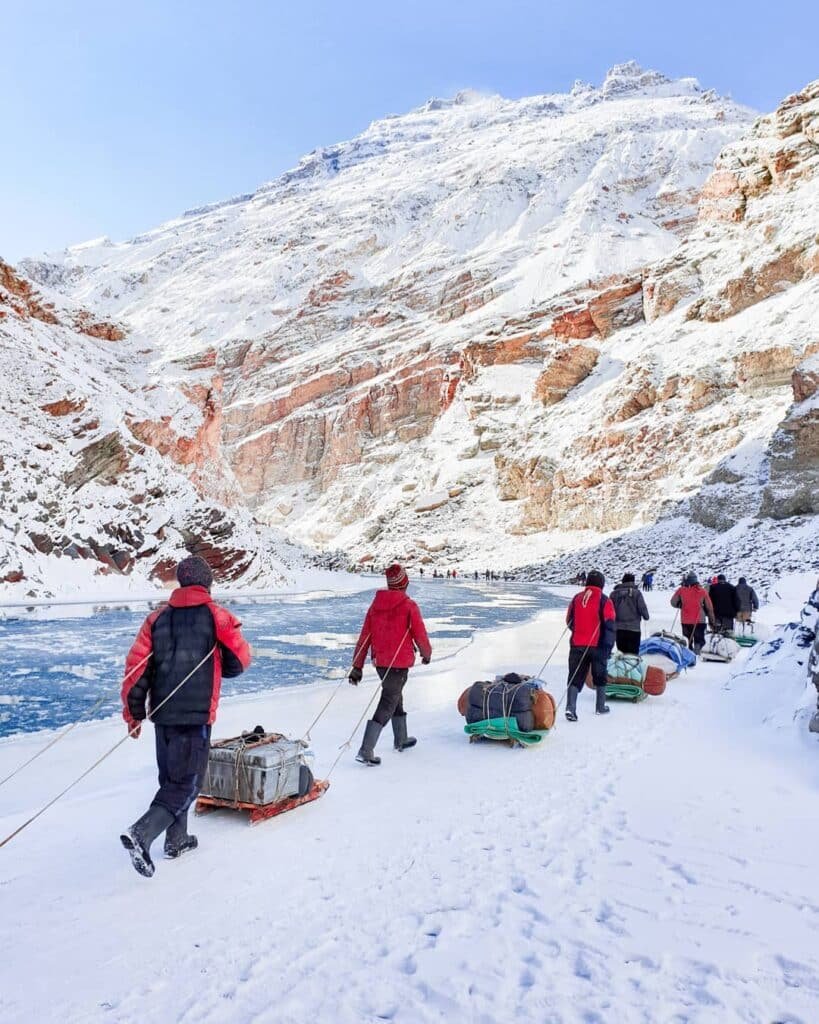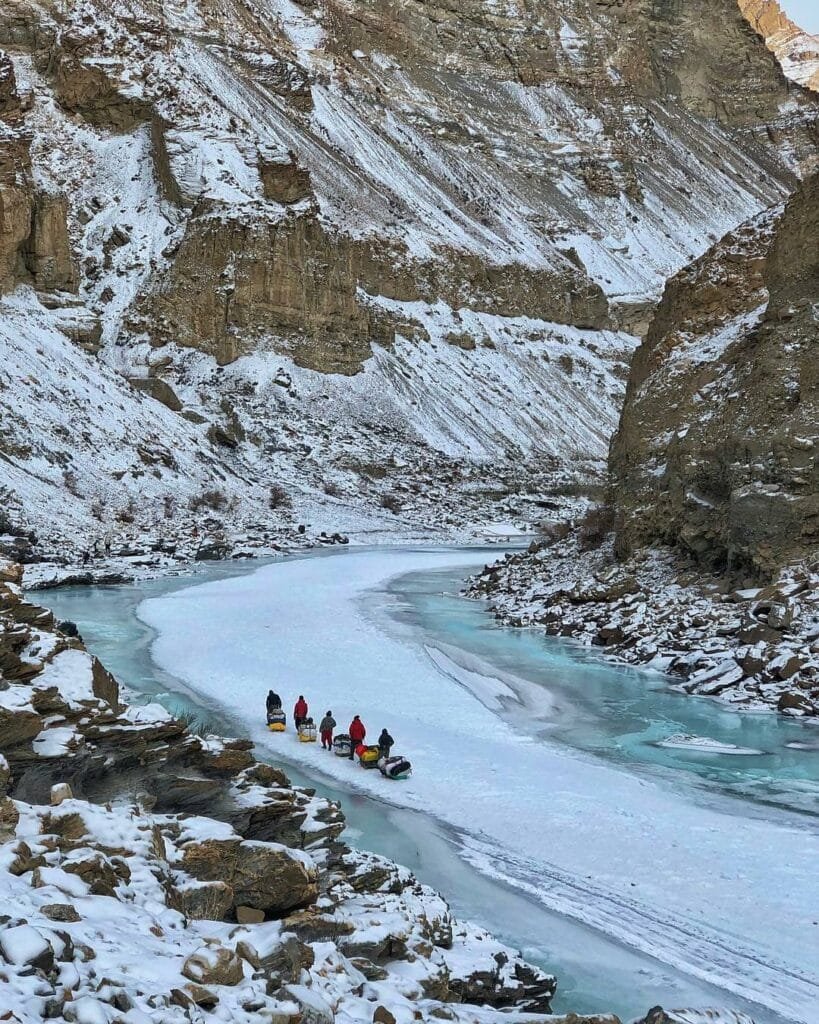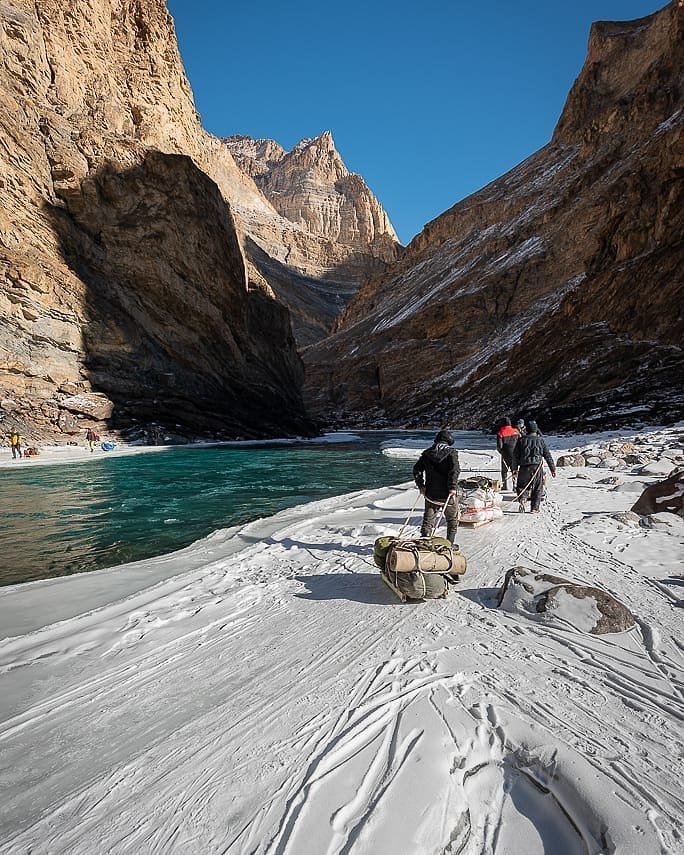Chadar Trek: The Ultimate Guide for 2024!
- Trekking Destinations
-
Aug 11
- Share post
Embark on a journey across the frozen Zanskar River, amidst snow-clad landscapes and majestic mountains. Welcome to Chadar Trek, the ‘Frozen River Trek’, a thrilling adventure deep within Ladakh’s icy wonderland. This blog post offers comprehensive information about this unique trek, from travel and accommodation to gear, guides, and permits. Read on to unravel the mysteries of the trek.
- Max Altitude: 11,123 Ft. (3,390M)
- Average Trekking Fees: ₹20,000 – ₹25,000
- Distance: 60 – 65 kms
- Difficulty: Difficult
- Duration: 7-8 days
- Ideal For: Experienced Trekkers Only
- Best Season: January - February
- Region: Ladakh
Table of Contents
ToggleIntroduction to Chadar Trek

Imagine embarking on a journey that takes you across a frozen river blanketed by a sheet of ice, with majestic mountains and snow-covered landscapes as your backdrop. This is the essence of Chadar Trek, one of the most thrilling and unique experiences trekking in India offers.
Known as the ‘Frozen River Trek’, the trek unfolds in Ladakh’s icy wonderland. The Zanskar River, cloaked in a thick layer of ice during winter months, creates an enchanting pathway for trekkers. This extraordinary natural phenomenon, where the river transforms into a frozen highway, is what gives the trek its name – ‘Chadar’ means blanket in Hindi.
The appeal of the trek lies not only in its unique setting but also in its cultural significance. For centuries, this icy path has been used by locals as a trade route during winters when all other paths are blocked by heavy snow. Now, it’s a sought-after adventure for thrill-seekers worldwide, drawn by the combination of physical challenge and breathtaking scenery.
As for timing your trip, the best time to go on the trek is from January to February. It’s during these chilly months that the Zanskar River freezes solid enough to walk on. But brace yourself – temperatures can drop down to -30 degrees Celsius at night!
A word of caution before you pack your bags for this adventure: this trek is not for the faint-hearted! The freezing temperatures, high altitude and challenging terrain require trekkers to be physically fit and mentally prepared. It’s recommended that participants have prior trekking experience and are comfortable with walking 5-6 hours daily on uneven icy terrain.
Ready to conquer the icy expanse? Strap up those trekking boots! The frozen river awaits…
Preparing for Chadar Trek

Adventure doesn’t knock on your door, you need to go knocking!
And when you’re knocking on the door of an adventure like the frozen river trek, preparation is key. So let’s dive in!
Physical Fitness Preparation
To conquer the icy path, you need a fair amount of physical fitness. High-altitude trekking is not a walk in the park! You’ll be treading on a frozen river, battling low temperatures and thin air. Regular cardiovascular exercises can be your best ally here. Engaging in activities such as running, cycling or swimming for at least 30 minutes every day, about two months prior to the trek can significantly boost your stamina.
Essential Gear and Equipment
As the saying goes, “There’s no such thing as bad weather, only unsuitable clothing”. For the trek, gear up with winter essentials such as:
- Trekking Shoes: Opt for high ankle waterproof shoes with good grip.
- Insulated Water Bottle: Hydration is crucial at high altitudes.
- Headlamp: Power cuts are frequent in Leh.
Remember to pack light yet smart!
Recommended Clothing
In the brutally cold terrain of Zanskar River valley, your clothing is your lifeline. Layering is the secret sauce to withstand the extreme temperatures.
- Base Layer: Thermal innerwear that traps body heat.
- Middle Layer: Fleece jacket for insulation.
- Outer Layer: Waterproof and windproof jacket.
Don’t forget thermal socks, woollen cap, gloves and sunglasses!
Acclimatization and Altitude Sickness
High altitude equals low oxygen levels. Your body needs time to adjust to this new environment – a process called acclimatization.
Importance of Acclimatization
Acclimatization minimizes the risk of altitude sickness which can turn fatal if ignored. Spending two days in Leh before starting the trek can help your body acclimatize.
Symptoms and Prevention of Altitude Sickness
Watch out for symptoms like headache, nausea or breathlessness. If you notice any of these signs:
- Descend immediately
- Keep yourself hydrated
- Avoid tobacco and alcohol
Tips for Acclimatizing Properly
- Increase altitude gradually
- Maintain a healthy diet
- Stay hydrated
Remember, slow and steady wins the race! Take it easy on the first few days of trekking.
Embarking on this difficult trek demands grit, determination and above all – thorough preparation. With these tips in your toolkit, you’ll be ready to brave the Icy Wonderland! The majestic Zanskar awaits you – tread its frozen path and etch an unforgettable memory into your adventurous hearts!
Getting to the Chadar Trek Base
The journey to the trek begins with an exhilarating travel to Leh, a high-desert city in the Himalayas. Nestled at an altitude of 3500 meters, Leh isn’t just any pitstop. It’s the gateway to your ultimate adventure!
Flights are the most convenient way to reach Leh, with regular services from Delhi. The aerial view of snow-capped mountains is a sight that sets the mood for your trekking expedition. Alternatively, if you’re up for a road trip, there are buses from Manali and Srinagar, but remember these routes are accessible only during summer and not during winter, so the only way to access Leh is via flights during the winter season.
Once you touch down in Leh, don’t rush off to the base camp yet! Your body needs time to adjust to the high altitude. Spend a couple of days exploring Leh’s charming monasteries and bustling markets. This period of acclimatization is crucial for a successful trek ahead.
With lungs full of mountain air and hearts pounding with excitement, it’s time to set off towards the trek base camp located at Chilling. There are shared taxis available from Leh which will take you on a scenic drive along the Indus River till you reach Chilling.
From Chilling, it’s a small hike to Tilad Do, your first encounter with the frozen Zanskar River and your actual starting point of this icy adventure. Be prepared as this is where reality hits – The Chadar Trek is not just another walk in the park!
While the journey to reach Chadar can seem daunting, Nomads of India are here to guide you every step of the way.
As we always say – The journey matters as much as the destination!
Budget & Costing

Before embarking on this adveture, it’s essential to plan your budget carefully. The total cost would depend on various factors such as mode of travel, accommodation type, gear and equipment, guides, permits, and other miscellaneous expenses.
Here are some estimated costs for your reference:
- Flights: A round trip flight from Delhi to Leh can range anywhere between ₹10,000 – ₹20,000 depending on when you book.
- Accommodation: Budget hotels in Leh can cost around ₹ 1,000 – 2,000 per night while a more luxurious stay can go up to ₹ 5,000 per night.
- Trekking Gear: Buying new trekking gear can hit your wallet hard. Consider renting equipment like trekking shoes, insulated water bottles and headlamps which can cost around ₹ 1,000 – 2,000.
- Trek Package: A comprehensive package from a reputed trekking company usually costs between ₹ 20,000 – 25,000. This generally includes accommodation, meals during the trek, first aid kit, guide charges and permit fees. The group size is usually around 20-25 people
Remember that these are estimated costs and actual expenses may vary. It’s always sensible to carry some extra cash for any unforeseen expenses. Happy budgeting!
But hey, don’t just take our word for it! Pack those bags, lace up those boots and let’s get ready for an unforgettable trip of a lifetime! We’ll continue our trekking story in our next section: Itinerary.
Next Stop: A day-by-day guide through this epic journey…
Chadar Trek Itinerary: Your Daily Dose of Adventure

Day 1: Your Arrival in Leh (3,500 M)
Your journey begins in Leh, the gateway to Ladakh with towering peaks. During the winter, the only viable route to Ladakh is by air, and flights from Delhi to Leh provide captivating aerial views of the Himalayas. Make sure to secure a window seat for breathtaking vistas.
Dedicate the first day to acclimatizing to the high altitude. As you transition from sea level, your body will need time to adjust to the mountain environment. While the Leh winters are harsh, this marks just the start of your cold weather experience.
2nd Day: Rest & Acclimatization in Leh (3,500M)
This day focused on helping you adapt to the altitude and climate. Take the opportunity to explore the city market, immerse yourself in the local culture, and visit nearby sites. Gradual movement aids in acclimatization. Also, utilize this time to review your checklist and make any last-minute purchases for the trek. Leh offers an excellent market for trek essentials.
Day 3: Further Acclimatization in Leh (3,500M)
On day three, the process of acclimatization continues. A necessary medical examination at the Tourist Information Centre is planned, playing a vital role in acquiring the required permits from ALTOA and the Wildlife Department for commencing the trek.
4th Day: Trek from Leh (3,500M) to Shingra Koma via Bakula (3,215M)
Distance: 70 km | Duration: 2-3 hours
Today marks the start of your trek as you drive to Bakula, the trek’s starting point. Beginning early, you’ll follow the scenic route along the Indus River, passing the confluence of the Indus and Zanskar Rivers at Nimmu. This picturesque 70 km journey, lasting about 3 hours, treats you to breathtaking views as you navigate narrow hairpin bends. As you approach Bakula, the frozen expanse of Zanskar unfolds before you. Upon transitioning to the Chadar, your trek leaders will guide you in traversing the icy terrain. Embrace the learning curve of walking on this glassy ice using the Penguin Walk technique, and you’ll quickly become adept.
One notable feature of the trek is the consistent, level terrain. There are no steep ascents or descents, and minimal altitude gain reduces the risk of altitude-related issues. Mastering today’s walk signifies adequate acclimatization, boding well for the trek ahead.
The appearance of the Chadar varies with weather conditions. It might be glassy, covered in powdery snow for better traction, or thinly iced in certain sections, requiring navigation through slush or along the riverbank. Safety lies in following the sledge route used by porters.
Depending on your pace, you should reach the next campsite in 3-4 hours. This marks your first night of Chadar camping.
Day 5: Trek from Shingra Koma to Tibb (3,280M)
Distance: 14 km | Duration: 6-7 hours
Waking up to the freezing cold entails leaving the warmth of your sleeping bag and tent. Yet, the hospitable people of Zanskar ensure a comforting start with hot tea and meals. Today’s 14 km journey to the next campsite spans 6-7 hours due to the challenges of Chadar walking. Remember to refill your thermos with warm water, as standard bottles succumb to the cold. Sunlight is a rarity in this gorge, appearing briefly due to the surrounding towering mountains. As you traverse the vast valley, relish the crisp air and the deep blue hue of the Zanskar river, mirroring the sky on clear days. Frozen waterfalls adorn the route. Pause by the river to cook meals and ensure energy levels remain ample. The final stretch to Tibb, about 200 meters, is captivating. Arrival at the campsite is anticipated by late afternoon.
Day 6: Trek from Tibb (3,280M) to Nerak (3,400M)
Distance: 12 km | Duration: 5-6 hours
Day six presents an encounter with the highlight of the trek, Nerak Waterfall. A substantial journey lies ahead, necessitating an early start to reach the waterfall by late afternoon. Amid the Zanskar Valley’s early sun departure, staying active is vital to staying warm. Noteworthy are the broken ice formations in the frozen river, forming captivating geometric patterns. Midway, a unique lunch awaits within a spacious cave. After arriving at the campsite, you’ll visit the awe-inspiring Nerak waterfall, a 30-minute walk away. Keep an eye out for domestic Yaks and relish the sight of the traditional wooden bridge juxtaposed with a modern counterpart. Time spent at Nerak waterfall is followed by dinner back at the campsite.
7th Day: Trek from Nerak (3,400M) to Tibb (3,280M)
Distance: 12 km | Duration: 6-7 hours
Following the exhilarating Nerak waterfall experience, you’ll trace your steps back to the Tibb campsite. The return journey, while familiar, offers a fresh perspective. The ever-changing frozen Zanskar River reacts to temperature fluctuations, transforming its appearance. Listen closely to the evolving sounds underfoot, a captivating aspect of Chadar trekking. Alongside the trail, local porters in traditional attire, called ‘Gonchas,’ demonstrate remarkable ease traversing the icy terrain. Their cheerful greeting of ‘Julley’ resonates – a Ladakhi welcome. Encounters with local songs and their adept sledging add cultural flair. As you penguin-walk to Tibb, the locals effortlessly overtake you.
Day 8: Trek from Tibb (3,280M) to Bakula (3,215M) and Return to Leh (3,500M)
Distance: 12-13 km | Duration: 7-8 hours
The final leg takes you full circle to Bakula, a 7-8 hour trek. From there, a 3-hour drive returns you to Leh, where you’ll spend the night in a hotel.
Day 9: Departure from Leh
The trek concludes. Given the unpredictable high-altitude weather and conditions, allocate buffer days between the trek’s end and your departure to accommodate travel arrangements.
“Every day on Chadar Trek is different, bringing new challenges and experiences!”
Camping & Accommodation
On the trek, your home under the stars changes every day! Camping sites are allocated by authorities based on safety considerations. You’ll be provided with high-quality tents that can withstand harsh weather conditions.
Activities & Attractions
Chadar Trek isn’t just about challenging yourself physically; it’s also about immersing yourself in nature’s beauty. From watching a sunrise over frozen Zanskar, visiting ancient monasteries in Leh, and walking through fascinating ice-formation landscapes, each day promises new sights that will leave you spellbound!
“Chadar Trek isn’t just a journey; it’s an experience that stays with you forever.”
Up Next? A Peek Into The Highlights Of Chadar Trek
But wait! There’s still so much more we haven’t touched upon —like those hypnotic frozen waterfalls or our encounters with local culture! So let’s continue our snowy saga and explore some highlights from this once-in-a-lifetime adventure!
Highlights of Chadar Trek

Embark on a journey where each step unveils a new wonder, each turn presents a vista more stunning than the last. Be it the awe-inspiring frozen waterfalls or the tranquil Zanskar River, this trek is replete with unique experiences and unforgettable sights.
Dance with Frozen Waterfalls
Imagine a waterfall, frozen in time, creating a spectacle so surreal that it leaves you breathless. The trek introduces you to such magnificent frozen waterfalls, an ethereal artwork of nature that defies description. It’s akin to walking through a dream, where cascading waters have been paused mid-fall, held captive by the cold winter air.
Surrender to Zanskar’s Charm
Next on the list is the hypnotic allure of the Zanskar River. Dressed in its winter attire, a glossy sheet of ice, it’s truly mesmerizing. The river becomes your constant companion along the trek, its gentle whispers echoing through the silent valleys. As you walk over its icy surface, you’ll be treated to views so enchanting they seem straight out of a fairy tale.
Lose Yourself in Nature’s Artistry
The landscapes here are nothing less than divine poetry etched in snow and ice. Each day breaks to unveil scenic views that can move even the most hardened hearts. The pristine white snow fields contrasted against clear blue skies will leave an indelible impression on your soul.
Immerse in Local Culture
Finally, don’t miss out on embracing the rich local culture of Ladakh. This trek isn’t just about physical endurance; it is also about understanding and appreciating the resilience of locals who thrive in these harsh conditions. Interact with them; their warmth and hospitality will add another layer to this already fulfilling experience.
Conclusion
The Chadar Trek experience? It’s more than just an adventure. It’s a transformation, a shift in perspective that only the daring ones get to witness. The frozen Zanskar river beneath your feet, the milky way above your head at night, and the adrenaline rush piercing through your veins – it’s an unforgettable journey etched in ice and memories.
Recall those moments of struggle, pushing through physical boundaries, braving extreme conditions. Remember how you emerged stronger, filled with a sense of achievement? That’s personal growth! You didn’t just conquer a trek; you conquered yourself.
“It’s not the mountain we conquer but ourselves.” – Edmund Hillary
And now? Now it’s time to pass on the torch. Encourage others to step out of their comfort zone and embrace this icy adventure. Share your experiences, tell them about the breathtaking views, the thrill of walking on a frozen river, and the silence of the mountains.
Because at the end of the day, it’s not just about reaching the summit or completing a trek. It’s about experiencing something extraordinary, something that makes your heart race and eyes sparkle with wonder.
So go on, and inspire someone today to embark on their own trek adventure. For there is no joy greater than inspiring another soul to explore the beauty of this world.
Don’t forget – every mountain top is within reach if you just keep climbing.
FAQs
The Chadar trek has not been banned. However, it’s important to note that the status of trekking routes and regulations can change over time. Before planning your trip, it’s advisable to check with local authorities and tour operators for the most up-to-date information on trekking permissions and bans.
The cost of the Chadar trek can vary depending on several factors, including the tour operator you choose, the duration of the trek, the inclusions (such as accommodation, meals, transportation), and any additional activities. On average, the cost could range from approximately ₹20,000 to ₹35,000 or more per person. It’s recommended to compare different tour packages and choose one that aligns with your budget and preferences.
Yes, the Chadar trek is considered to be a challenging and potentially risky adventure due to its extreme weather conditions and the frozen Zanskar River. The temperatures can drop significantly, and the frozen river conditions can change rapidly, leading to cracks or holes in the ice. Trekkers need to be prepared for sub-zero temperatures, altitude-related concerns, and the unpredictable nature of the ice. Proper planning, experienced guides, and appropriate gear are crucial to mitigate the risks associated with this trek.
The Chadar trek is known for its difficulty and harsh conditions, making it less suitable for beginners. It demands a certain level of physical fitness, mental resilience, and prior trekking experience. It’s advisable for individuals attempting the Chadar trek to have some experience in high-altitude treks, cold-weather conditions, and challenging terrains. If you are a beginner, it’s recommended to gain trekking experience on less demanding trails before considering the Chadar trek. Always consult with trekking experts and guides to assess your readiness for such a demanding adventure.
Comments
Add a comment
Leave a Reply · Cancel reply
This site uses Akismet to reduce spam. Learn how your comment data is processed.
